97282 Derringer Tuner for 2014-2018 and 2020+ Ram 1500 3.0L EcoDiesel, 2014-2018 and 2020+ Jeep Wrangler/Gladiator 3.0L EcoDiesel
INSTALL INSTRUCTIONS
Part #s
66641, 66681, 66794, 66797, 66798, 66799
Banks Derringer® Diesel Tuner
2014-2018 3.0L EcoDiesel RAM 1500
2014-2018 3.0L EcoDiesel Jeep Grand Cherokee
2019+ RAM 1500
2020+ Jeep Wrangler/Gladiator 3.0L EcoDiesel
Please read through the following instructions thoroughly before starting your installation. If you have any questions please visit our Support Page.

- Socket Wrench
- Socket Extension
- 8mm Socket
- 10mm Socket
- 14mm Socket
- Flathead Screwdriver
- Clippers
- Assorted Picks
- Small Mirror (Optional)
- Zip Ties (Optional)
Starter Info for RAM Trucks
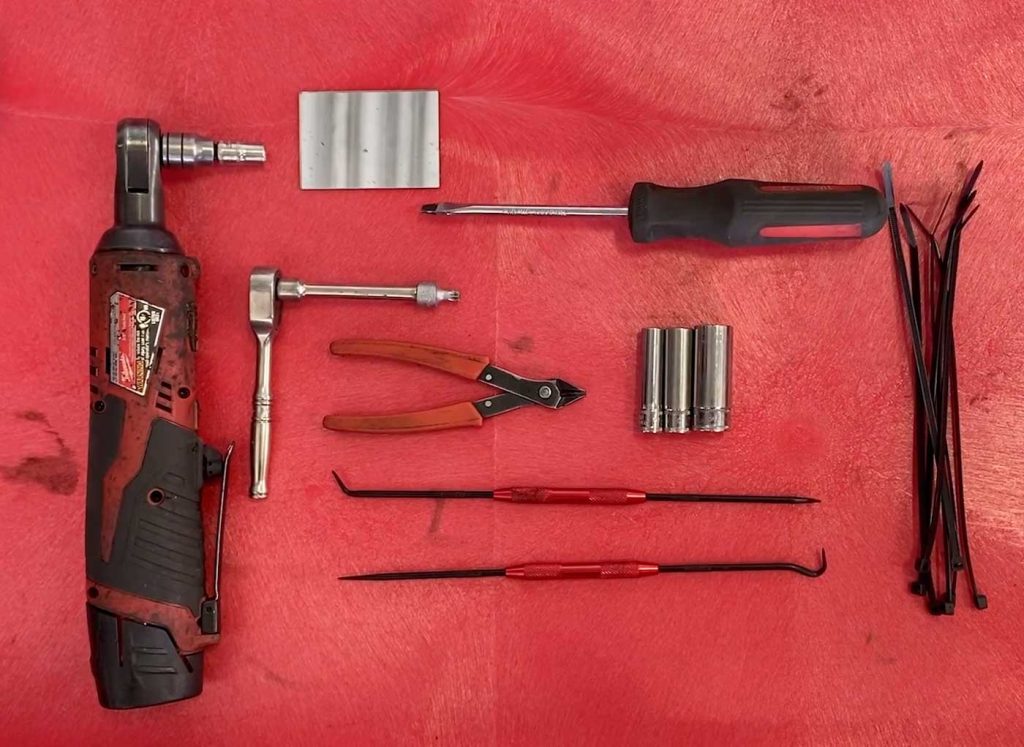
Required Tools
Socket Wrench
Socket Extension
8mm Socket
10mm Socket
14mm Socket
Flathead Screwdriver
Clippers
Assorted Picks
Small Mirror (Optional)
Starter Info for Jeeps

Required Tools
Socket Wrench
Socket Extension
10mm Socket
14mm Socket
T-27 Torx Bit
Flathead Screwdriver
Clippers
7mm Nut Driver
Thank you for purchasing the Banks Derringer in-line tuner for the RAM Eco-Diesel!
General Installation Practice
Disclaimers
Derringer Hardware Differences

The Derringer is produced in two different form factors.
Generation 1
(PN 61312) is an over-molded design with a pigtail 8-pin connector.
Generation 2
(PN 61313, 66797, 66798, 66799) is housed in a hard plastic case with an integrated 12-pin connector. The function and operation and capability of the GENERATION 1 Derringer and GENERATION 2 Derringer are identical; just the looks and feel of the module have been revised.
NOTE:
The images shown in this manual are for the installation of a GENERATION 1 Derringer. The process for installing the GENERATION 2 is identical.
Section 1: Remove Components

1. Before beginning, disconnect the negative terminal of the battery.

2. Once the battery is disconnected, remove the engine cover.
2014-2018 Ram 1500 – First remove the oil cap. Then, lift up at the front to release the rubber socket mounts and pull forward to release from the rear mounts. Reinstall the oil filler cap.
For 2020+ vehicles remove the two 10mm bolts holding the cover on.
NOTE: If installing in a 2014-2018 Jeep Grand Cherokee, skip steps 3 & 4 and proceed to step 5.

3. Remove the intake hose.

4. There are four mounting locations and one sensor to disconnect.
Using the 8mm socket, loosen the hose clamp on one end of the intake.
There is a clamp that’s partially covered by the lip of the firewall.
Remove the third bolt attached to the bracket.

5. Disconnect the closed crankcase heater ventilation connector.

6. Squeeze the clamp at the base of the crankcase breather hose to disconnect it.

7. Pull the intake up and out, but do not fully remove.

8. There’s a small harness clip attached to the intake, remove the clip to disconnect the harness.
Now you can fully remove the intake hose.

9. Remove the charge air cooler hose from the turbocharger.
Using a 14mm socket, remove the bolt retaining the duct to the engine.
Loosen the hose clamp at the bottom of the duct using an 8mm socket.

9A. Using a flathead screwdriver or pick, pry the metal retaining clip up until it clicks out.

10. Gently slide the duct off the elbow and remove the duct.

11. Move the sound deadening foam out of the way so you have visual access to the FRP (fuel rail pressure) sensor.
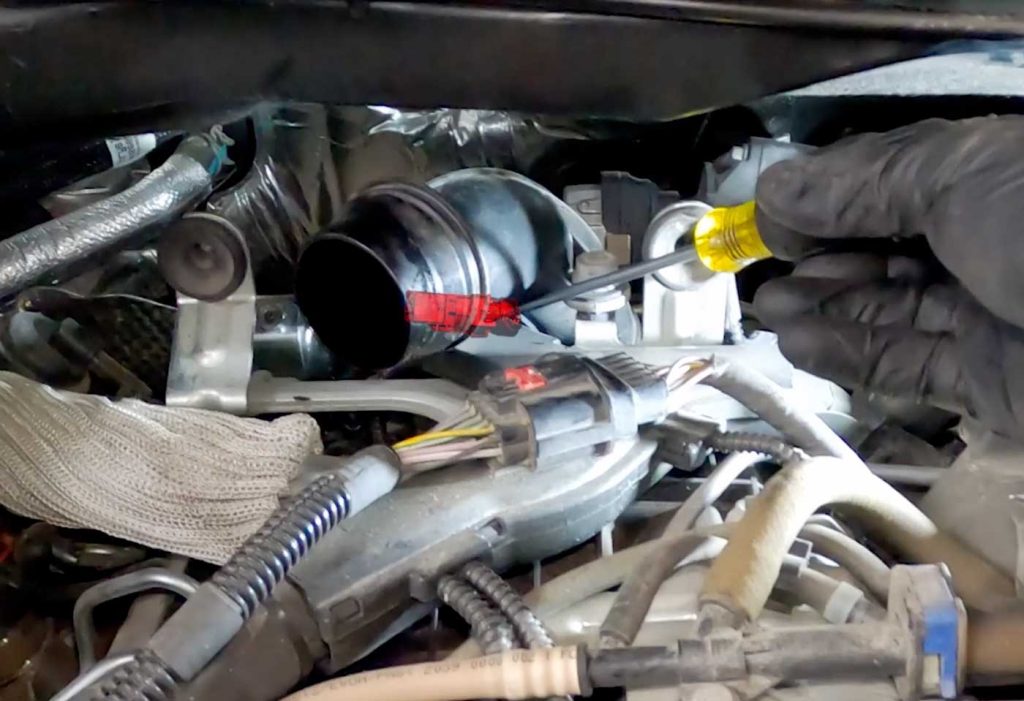
12. It’s time to remove the MAP sensor.
Clocking the sensor can determine how difficult the remaining steps will be.
From 9 to 3 o’clock – you should be able to easily unlock and disconnect the sensor.
Locked at 6 o’clock – this will be the most difficult orientation.
Once you’ve made the orientation of the sensor, disconnect the MAP sensor.

13. Using a flathead screwdriver, you can see the locking tab on the MAP sensor through the bracket.
Unlock the tab and squeeze the sensor to disconnect and then store it for future use.
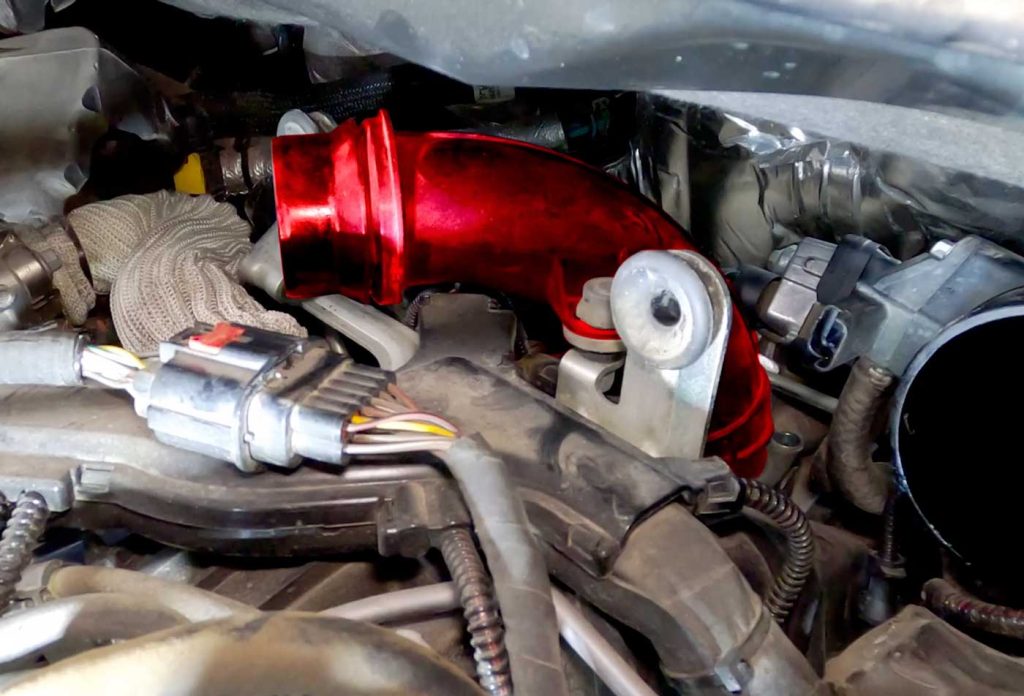
14. Remove the turbo outlet elbow coming off the turbocharger.
Using the T-30 Torx, access the two bolts on the bottom of the flange of the elbow.
Remove the two bolts and wiggle the elbow to remove it.

15. Disconnect the air temperature sensor on the backside of the elbow by sliding the red locking mechanism back and depressing the tab and pulling the connection apart.

16. Now it’s time to disconnect the fuel rail pressure sensor.
Verify the orientation of the sensor.

17. As shown in the video above, the locking mechanism is hidden on the underside of the sensor.
You’ll need to slide the locking mechanism back. Then squeeze the tab to release.
We used a small mirror to help us guide our tools.
Once you hear and feel the click of the locking mechanism, you can squeeze the tab and pull the sensor off its housing.
Use a small flathead screwdriver to keep pressure on the sensor as you disconnect it.
18. Set aside the disconnected sensor, as you will be plugging it into the Derringer.
Section 2: Installing the Derringer

1. Begin installing the Derringer by first connecting the wiring harness.
2. The wire harness extension is marked FRP and MAP.
The FRP is a three-pin connector.
While the MAP is a four-pin connector.

3. Connect the Banks FRP extension to the factory FRP sensor.

4. Install the FRP extension connector into the back of the fuel rail and push until you hear a click.

5. Reinstall the turbo outlet elbow back on top of the turbocharger.
6. Place the two bolts back into their position and tighten slightly to help hold the elbow in place.
7. Use the T-30 Torx to fasten the bolts back into position.
8. Reconnect the air temp sensor on the backside of the elbow.
9. Reconnect the MAP sensor.
Clip the Banks harness extension into the factory MAP sensor.
Use the flathead screwdriver to help push the locking mechanism back into the locked position.

10. Connect the Banks harness extension into the main wiring harness.

11. Lay the Banks harness extension out in your desired route.
Be sure to avoid areas of extreme temps and moving/rotating parts.

12. Move back or reinstall the sound deadening foam.

13. Reinstall the charge air cooler hose.
Slide the upper end back over the turbo outlet elbow until you hear the click of the retaining clip going back into position.
Then slide the bottom of the hose back into the tube and tighten down the hose clamp with an 8mm socket.
Reinstall the bolt for the mid-point bracket using a 14mm socket.

14. Reinstall the intake hose.
Slide the rubber boots back onto their respective ends of the system.
Push the center mount down until you feel it pop into position.

15. Reinstall the crankcase breather hose by pushing it firmly onto the duct.

16. Reconnect the closed crankcase heater ventilation connector.

17. Reattach the wire harness to the intake hose.
18. Ensure that the intake hose is properly over the ducts and use your 8mm socket to fasten them.

19. Install the 10mm bolt at the center bracket of the intake hose.

20. Reinstall the engine cover.
Secure it by reinstalling the two 10mm bolts.
Section 3: Installing the iDash

1. Use a coat hanger and low adhesive tape to tape the iDash cable to the hanger to fish them through the firewall.
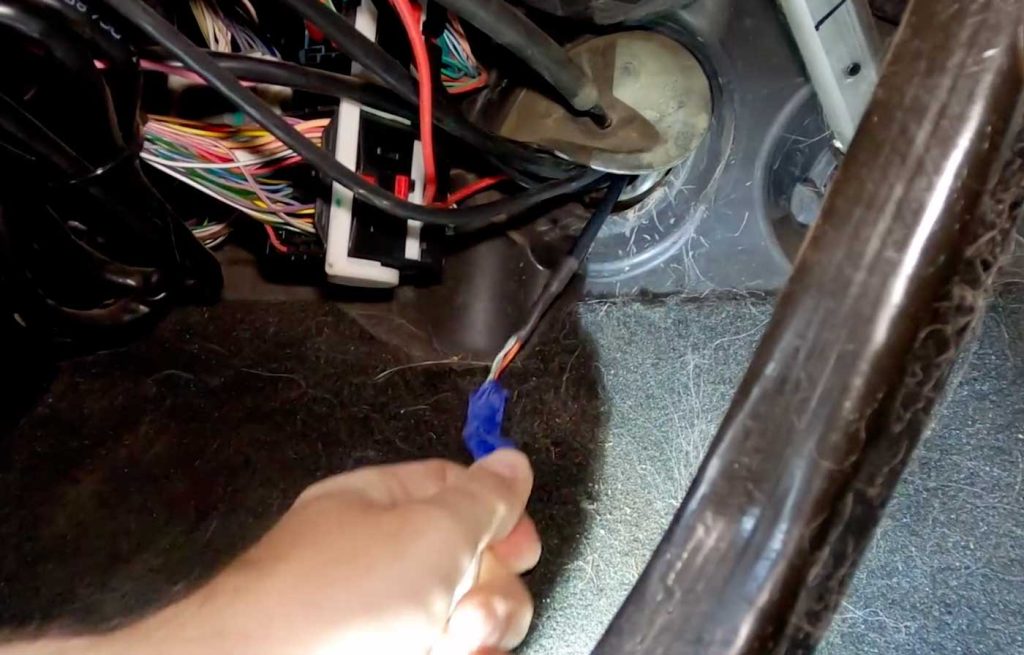
2. Pull the fish through the hole and pull in as much as the iDash cable as possible. Remove the tape and set it aside.

3. Take the Banks Derringer cable harness and plug it into the bottom of the Derringer.

4A. Connect the iDash cable to the Derringer by lining up the keying features.
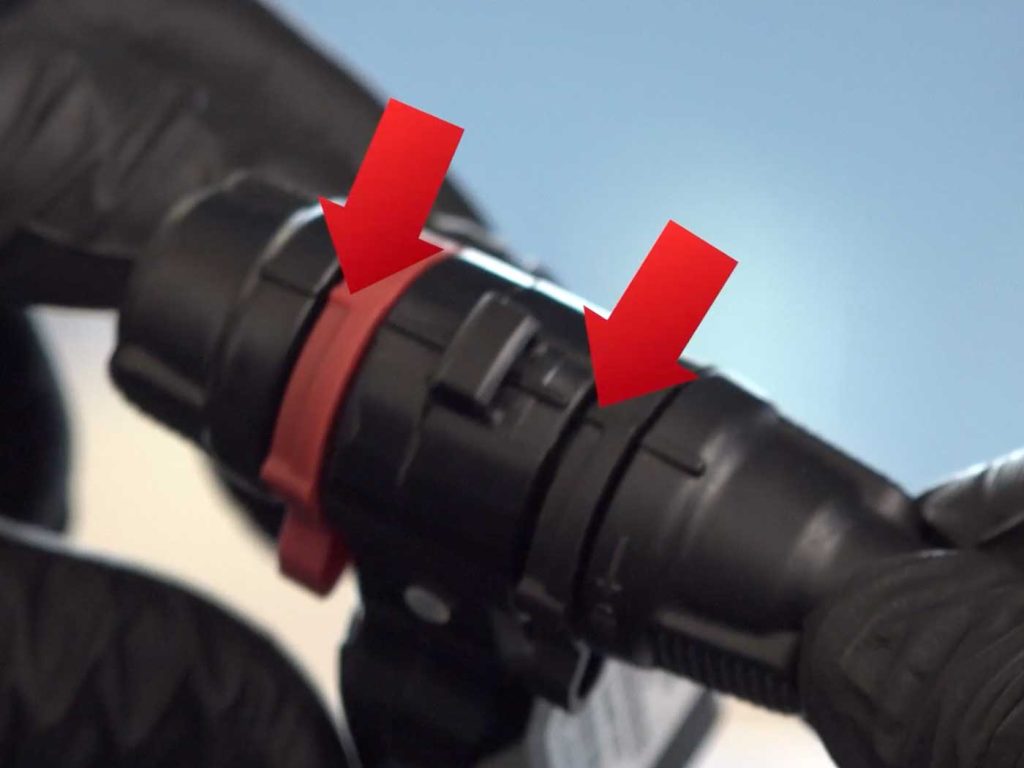
4B. Lock it into place by twisting the outer ring to line up the indicators.

5. Choose the desired location for your Derringer module.
Using the supplied zip ties, secure the Derringer.
6. Go back through the harness routing and make sure that it is clear of any moving parts or areas of extreme temperatures.

7. Secure the routing using the supplied zip ties.

8. In the cabin of the truck, connect the iDash.
Remove the side panel of the dashboard.
Fish the iDash, Derringer, and OBD cables through the side of the dashboard.

9. Connect the Derringer to the iDash.
If you already have the iDash installed, remove it from the mount in order to access the connectors.
There are two connections on the back of the iDash.
The Derringer cable plugs into the 6-pin slot, and the OBD-II plugs into the 4-pin slot.

10. Tuck away the cables and mount the iDash.

11. Connect the OBD cable to the OBD-II port.

12. Put the side panel back on the dashboard.
Secure the cables to ensure they do not catch your feet while driving.

13. Reconnect the battery and power up the truck to confirm that the Derringer is connected and working properly.

CARB EO Label
Please use the following CARB-approved emissions label and EO label location guidelines. We generally use the radiator shroud location.
Congratulations!
You have now installed the Derringer Tuner!

